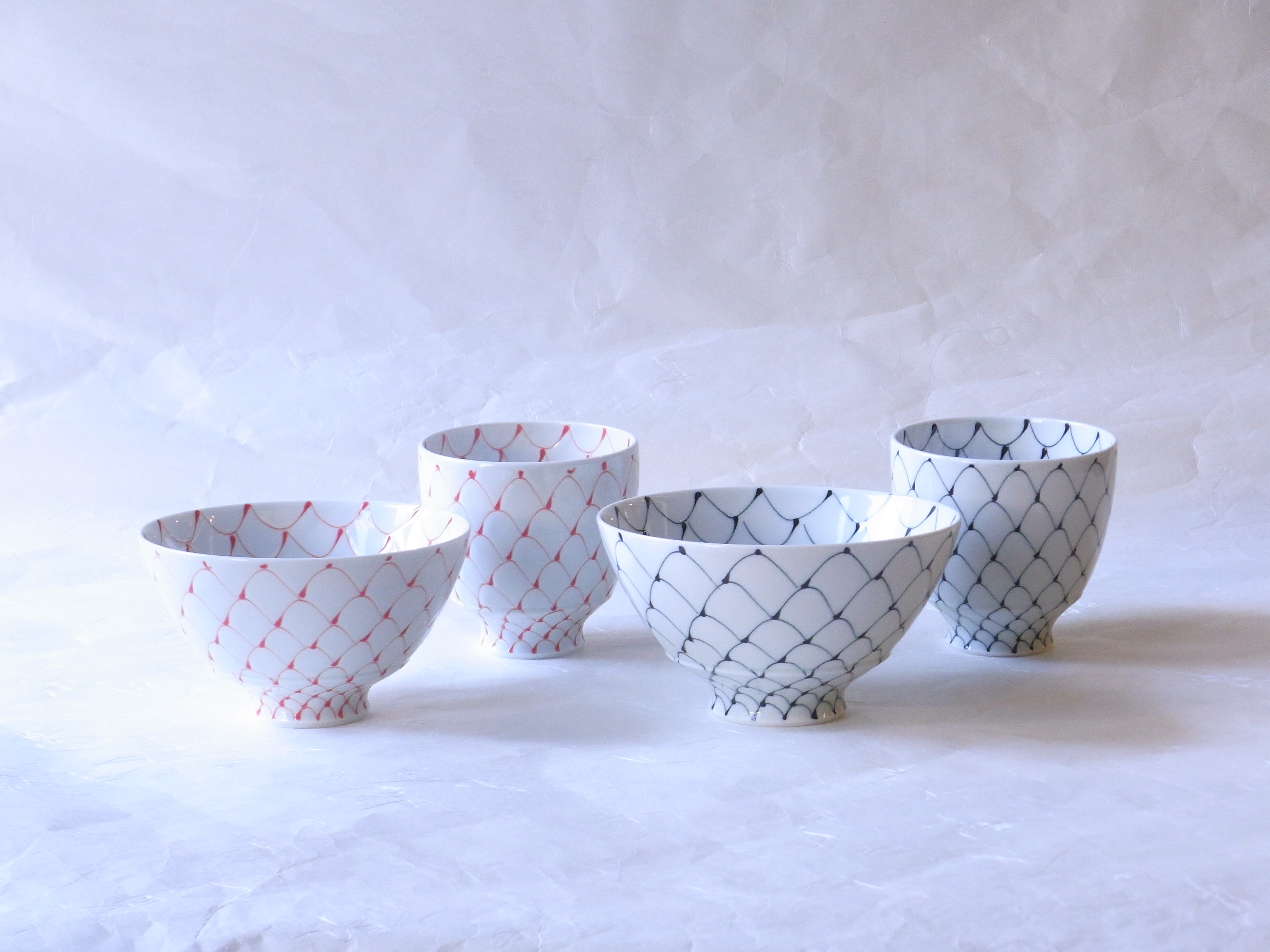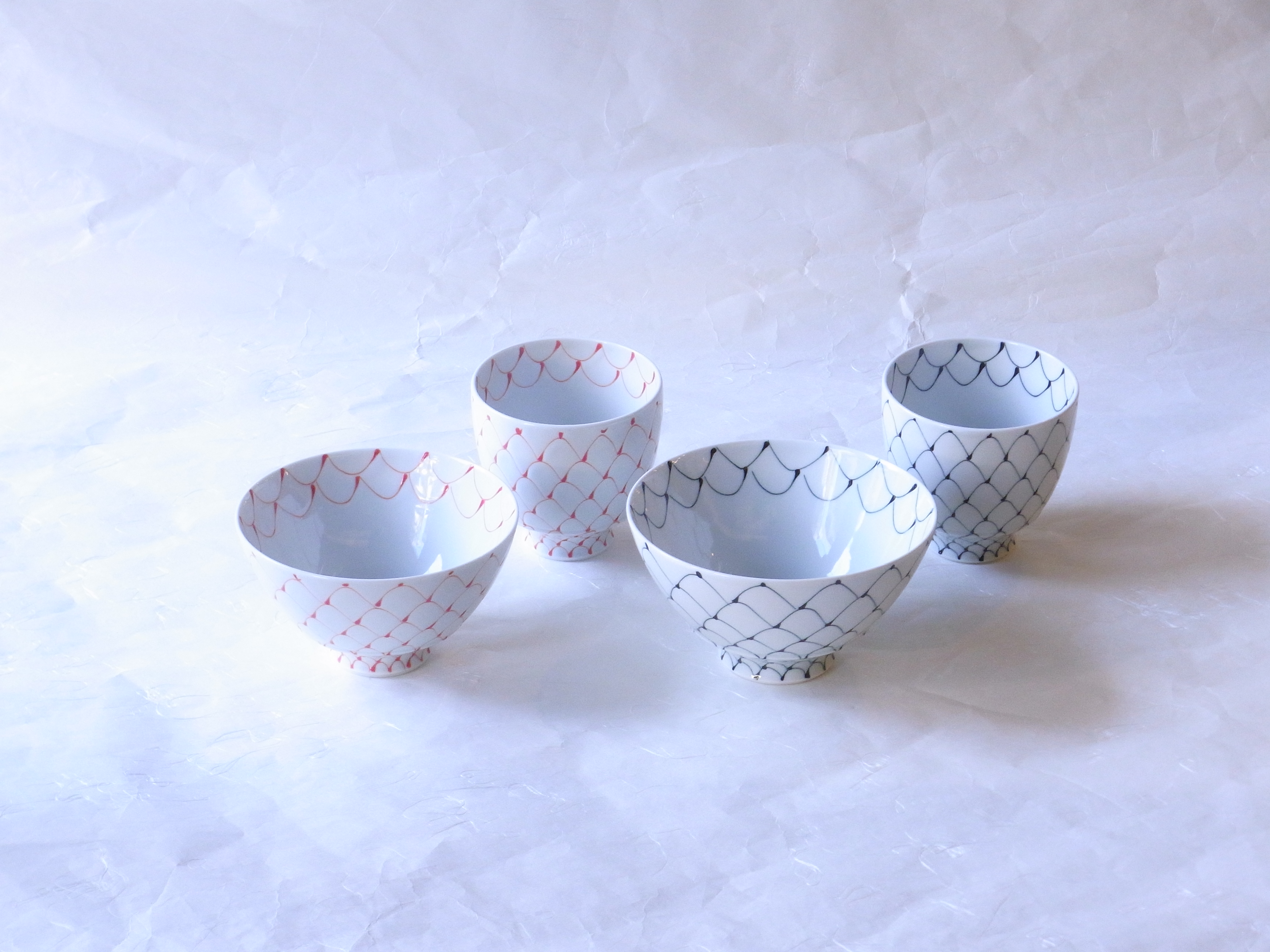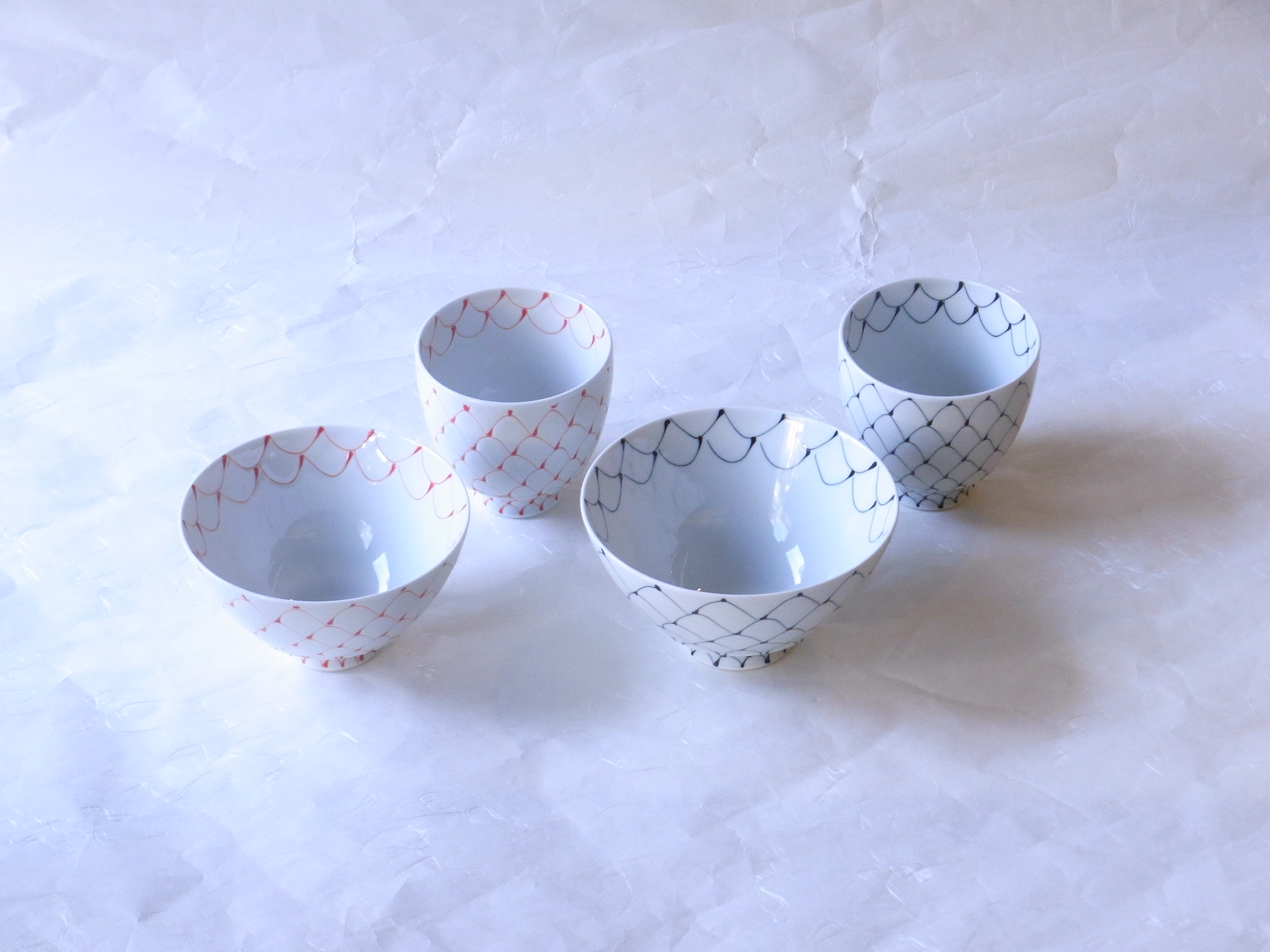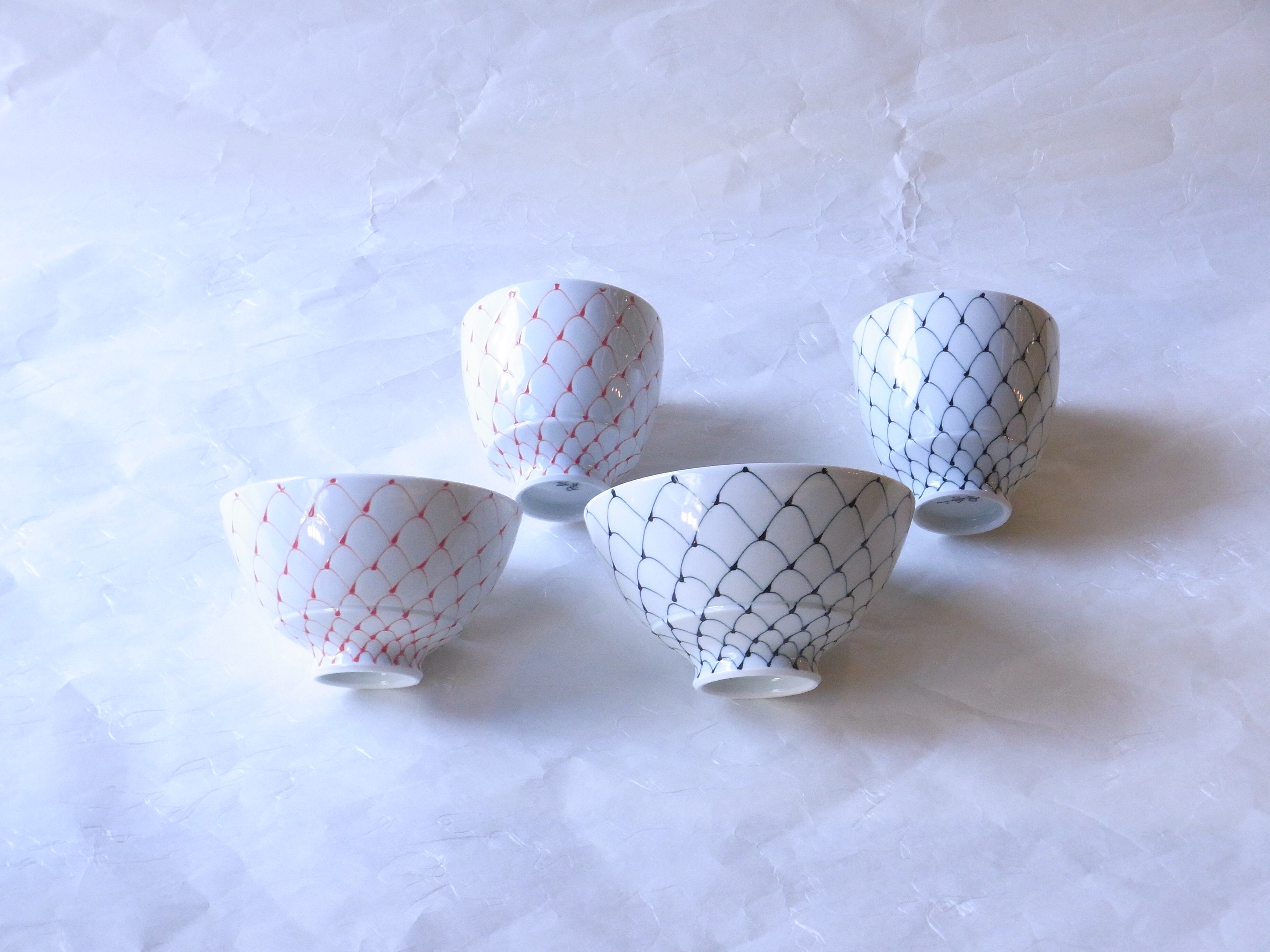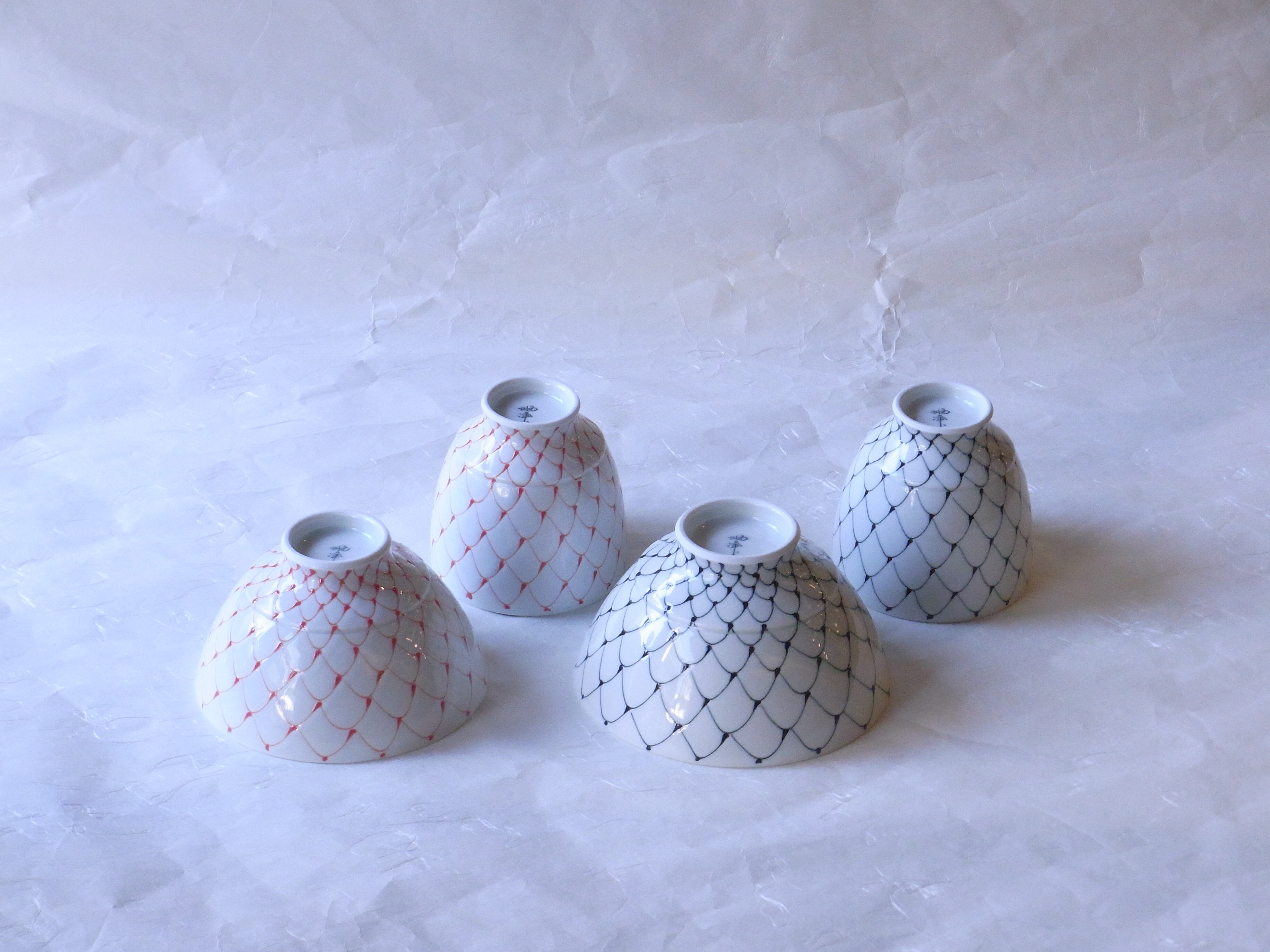有田焼から夫婦飯碗と組湯呑の睦セットのご紹介です。
白磁の生地に全面に手描きをされた呉須と朱のペアのご飯茶碗と
ペアの湯呑がセットになったものです。
湯呑は同じサイズですが、ご飯茶碗は呉須の方が大きくなっています。
高台が下へ行くほど広がっているので、高台を持って持ち上げることも出来ます。
この器は「一珍」(いっちん)という技法を使って描かれています。
「一珍」とは簡単にいうと、チューブのようなものから色を押し出して
文様を描く装飾技法で、連続して色が出るため線状の模様を描かれることが多いです。
また、チューブのようなものから出るので、絵柄が立体的になるのが特徴となります。
この器も網目が「一珍」で描かれているので、色が盛り上がっており立体的になっています。
網目の柄は昔から、大漁とか一網打尽を連想させ、縁起のいい柄なので
好んで網目柄の器を使う方がいらっしゃいます。
網目柄は同じ模様を繰り返すことから「永遠に続くもの」を意味し、
「健康が続く」長寿の象徴とされてきました。
「網」で福を「からめとる」とか「すくいとる」意味があり、縁起のいい吉祥文です。
また、網目は人間の血管に似ていることから
「網目のご飯茶碗でご飯を食べると、中風(脳出血・脳梗塞)にならない」
という言い伝えも残っています。
また、「結びつきが強く、離れない」という意味もあるそうです。
健康運を高められる器として、ご自分用でも、プレゼントにもなるものです。
この器は磁器製なので焼きが堅く、欠けにくく割れにくくなっています。
また一つひとつ手描きで描かれており、大変な手間と熟練の技術が
注ぎ込まれています。
年の初めや、敬老の日や誕生日や婚礼などのお祝い事の際の贈り物など
相手を思いやる気持ちが込められるプレゼントとなります。
飯碗 呉須 径 12.5㎝ 高さ 7㎝
飯碗 朱 径 11.5㎝ 高さ 6.5㎝
湯呑 径 8㎝ 高さ 8㎝
It is an introduction of the rice bowl and the kumiyu bowl set from Arita ware.
The rice bowl of the pair of the rose and the rose which was hand-drawn on the entire surface in the cloth of white porcelain
It is the one that the hot water bowl of the pair became a set.
The hot water bowl is the same size, but the rice bowl is larger than the rice bowl.
Because the height extends as it goes down, it is possible to lift it with the height.
This vessel is drawn using a technique called “Ichichin”.
To put it simply, “Ichichin” is to push the color out of something like a tube.
It is a decorative technique to draw a pattern, and it is often drawn a linear pattern because the color comes out continuously.
In addition, since it comes out from something like a tube, it is characterized by the three-dimensional design.
Because the mesh is drawn in “Ichichin”, the color is raised and it is three-dimensional.
The pattern of the net is reminiscent of a big catch or a net all-out from old times, and it is a lucky pattern.
There is a person who likes to use the container of the mesh pattern.
The mesh pattern means “things that last forever” from repeating the same pattern,
It has been a symbol of longevity that “health continues”.
It is a lucky Yoshiyoshi sentence that has the meaning of “karameto” or “sukutoru” of fortune in “net”.
In addition, because the mesh is similar to human blood vessels,
“If you eat rice in a rice bowl with a net, you won’t get a medium wind (cerebral hemorrhage, cerebral infarction).”
There is also a legend that.
In addition, it seems to mean that “the connection is strong, and it does not leave”.
As a vessel to improve health luck, it is also for yourself, it is also a gift.
Because this porcelain is made of porcelain, it is hard to bake, it is hard to chip and hard to crack.
In addition, it is drawn by hand one by one, and a great deal of effort and skilled skill
It is poured.
Gifts at the beginning of the year, respect for the Aged Day, birthdays, weddings, etc.
It will be a present that you can put the feeling of caring for the other party.
這是介紹已婚夫婦飯碗和湯碗的一套從阿裡塔陶器。
用一對米餅和栗子在白瓷織物上手繪成全面
一對熱水杯變成了一套。
熱水的大小相同,但飯碗比米蘇大。
因為高地已經蔓延得越高,你可以舉起一個高的地高。
這個儀器是用一種技術繪製的。
簡單地說,”奇奇”是從管之類的東西中擠出顏色。
在圖案的裝飾技術中,通常繪製線條圖案,以便連續著色。
此外,由於它從管子之類的東西出來,圖案成為三維的。
這個容器也畫在”一個罕見的”網格,所以顏色是上升的,它已成為三維。
網眼的圖案讓人想起大漁獲或一網擊,因為吉祥的圖案
有些人喜歡使用網狀容器。
網格圖案意味著”永遠持續”,因為重複相同的模式,
健康是長壽的象徵。
在”網”中,有”吃”或”吃”的意思,吉祥的吉祥句。
此外,由於網路類似于人類血管。
“如果你吃米飯與網飯碗,它不會成為中風(腦出血,腦梗死)。
有一個傳承。
此外,似乎有一個含義,”連接是強大的,不離開”。
作為增加健康運氣的容器,它是為自己和禮物。
這個容器是瓷器,所以烘烤是硬的,很難切緊,很難打破。
此外,它畫在手繪每一個,和艱苦的工作和熟練的技術
澆注。
在年初或慶祝禮物,如敬老日或生日或婚禮
它成為禮物,表達你關心的人的感覺。
这是介绍已婚夫妇饭碗和汤碗的一套从阿里塔陶器。
用一对米饼和栗子在白瓷织物上手绘成全面
一对热水杯变成了一套。
热水的大小相同,但饭碗比米苏大。
因为高地已经蔓延得越高,你可以举起一个高的地高。
这个仪器是用一种技术绘制的。
简单地说,”奇奇”是从管之类的东西中挤出颜色。
在图案的装饰技术中,通常绘制线条图案,以便连续着色。
此外,由于它从管子之类的东西出来,图案成为三维的。
这个容器也画在”一个罕见的”网格,所以颜色是上升的,它已成为三维。
网眼的图案让人想起大渔获或一网击,因为吉祥的图案
有些人喜欢使用网状容器。
网格图案意味着”永远持续”,因为重复相同的模式,
健康是长寿的象征。
在”网”中,有”吃”或”吃”的意思,吉祥的吉祥句。
此外,由于网络类似于人类血管。
“如果你吃米饭与网饭碗,它不会成为中风(脑出血,脑梗死)。
有一个传承。
此外,似乎有一个含义,”连接是强大的,不离开”。
作为增加健康运气的容器,它是为自己和礼物。
这个容器是瓷器,所以烘烤是硬的,很难切紧,很难打破。
此外,它画在手绘每一个,和艰苦的工作和熟练的技术
浇注。
在年初或庆祝礼物,如敬老日或生日或婚礼
它成为礼物,表达你关心的人的感觉。
